Contract Law: Elements and Vicarious Liability
VerifiedAdded on 2020/02/05
|16
|4933
|270
AI Summary
This assignment delves into the fundamental concepts of contract law, examining the essential elements required for a valid contract. It further explores the concept of vicarious liability, analyzing its application in legal contexts. The assignment draws upon academic sources, textbooks, and online resources to provide a comprehensive understanding of these key legal principles.
Contribute Materials
Your contribution can guide someone’s learning journey. Share your
documents today.
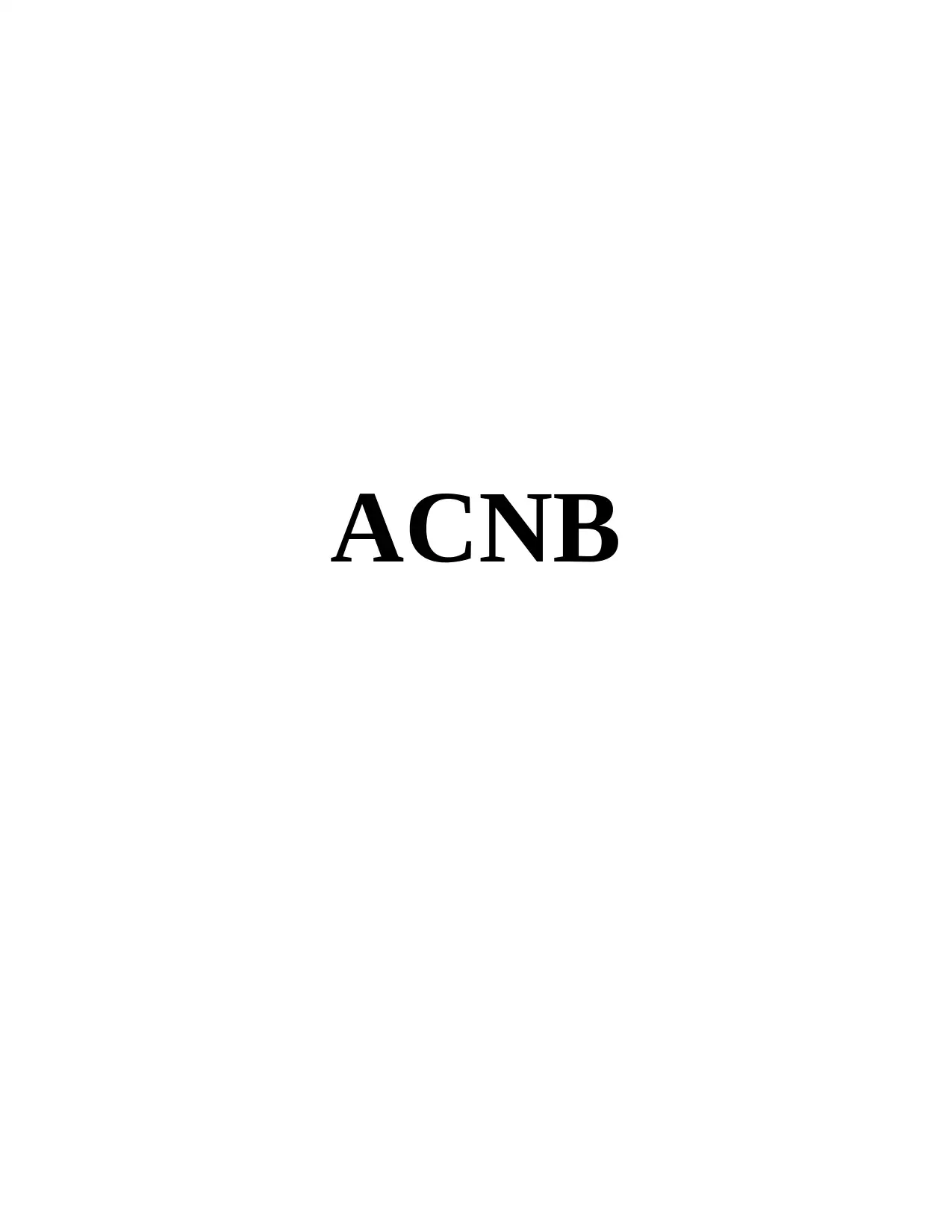
ACNB
Secure Best Marks with AI Grader
Need help grading? Try our AI Grader for instant feedback on your assignments.
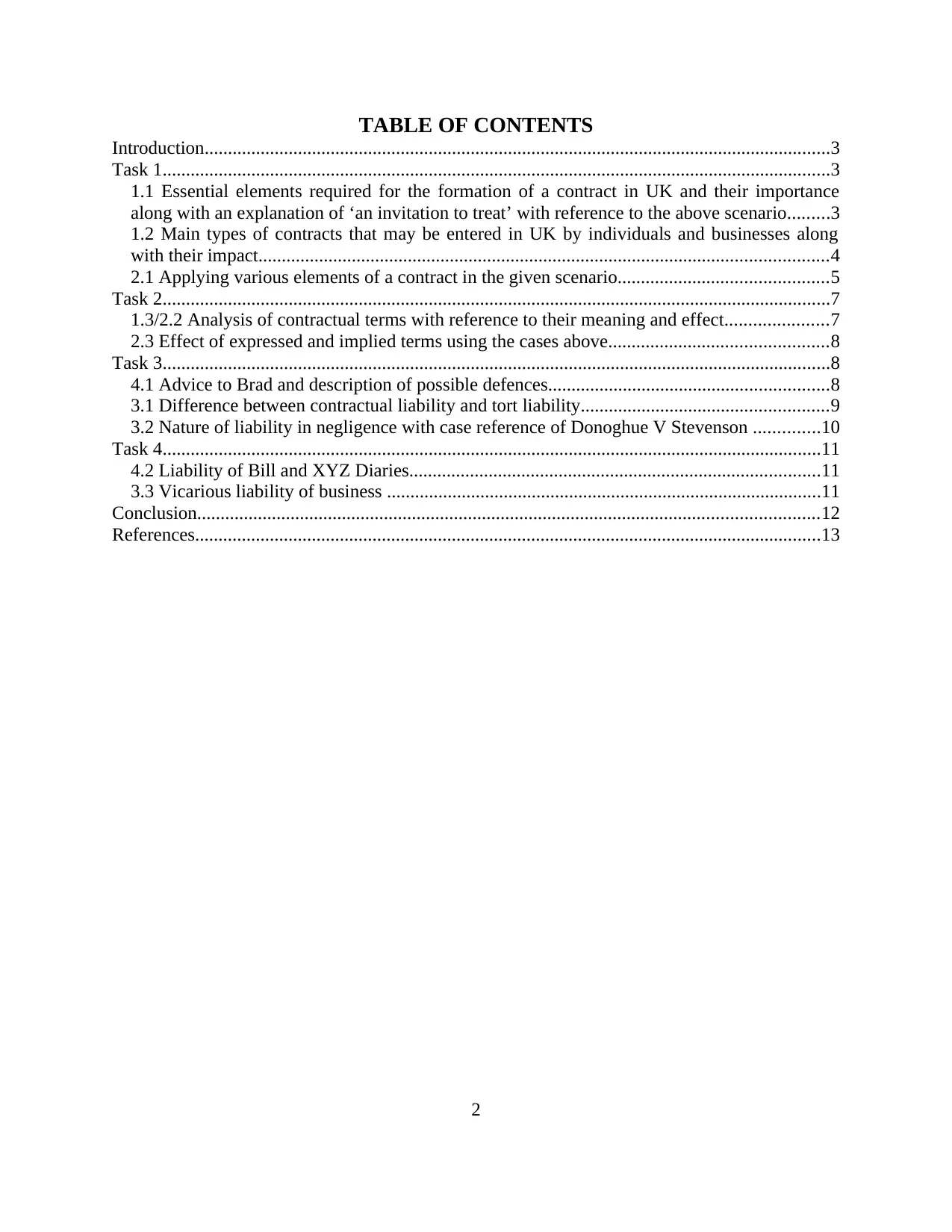
TABLE OF CONTENTS
Introduction......................................................................................................................................3
Task 1...............................................................................................................................................3
1.1 Essential elements required for the formation of a contract in UK and their importance
along with an explanation of ‘an invitation to treat’ with reference to the above scenario.........3
1.2 Main types of contracts that may be entered in UK by individuals and businesses along
with their impact..........................................................................................................................4
2.1 Applying various elements of a contract in the given scenario.............................................5
Task 2...............................................................................................................................................7
1.3/2.2 Analysis of contractual terms with reference to their meaning and effect......................7
2.3 Effect of expressed and implied terms using the cases above...............................................8
Task 3...............................................................................................................................................8
4.1 Advice to Brad and description of possible defences............................................................8
3.1 Difference between contractual liability and tort liability.....................................................9
3.2 Nature of liability in negligence with case reference of Donoghue V Stevenson ..............10
Task 4.............................................................................................................................................11
4.2 Liability of Bill and XYZ Diaries........................................................................................11
3.3 Vicarious liability of business .............................................................................................11
Conclusion.....................................................................................................................................12
References......................................................................................................................................13
2
Introduction......................................................................................................................................3
Task 1...............................................................................................................................................3
1.1 Essential elements required for the formation of a contract in UK and their importance
along with an explanation of ‘an invitation to treat’ with reference to the above scenario.........3
1.2 Main types of contracts that may be entered in UK by individuals and businesses along
with their impact..........................................................................................................................4
2.1 Applying various elements of a contract in the given scenario.............................................5
Task 2...............................................................................................................................................7
1.3/2.2 Analysis of contractual terms with reference to their meaning and effect......................7
2.3 Effect of expressed and implied terms using the cases above...............................................8
Task 3...............................................................................................................................................8
4.1 Advice to Brad and description of possible defences............................................................8
3.1 Difference between contractual liability and tort liability.....................................................9
3.2 Nature of liability in negligence with case reference of Donoghue V Stevenson ..............10
Task 4.............................................................................................................................................11
4.2 Liability of Bill and XYZ Diaries........................................................................................11
3.3 Vicarious liability of business .............................................................................................11
Conclusion.....................................................................................................................................12
References......................................................................................................................................13
2
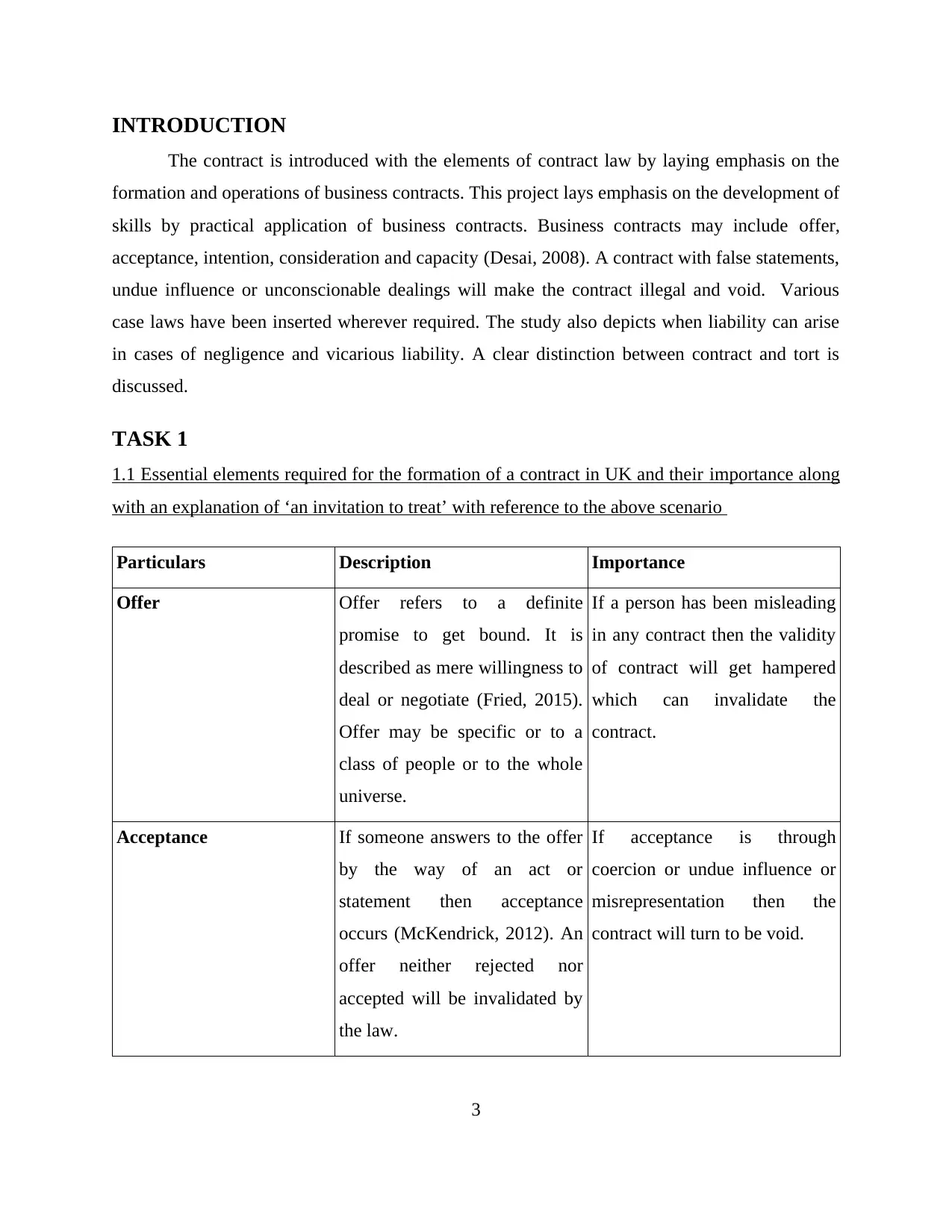
INTRODUCTION
The contract is introduced with the elements of contract law by laying emphasis on the
formation and operations of business contracts. This project lays emphasis on the development of
skills by practical application of business contracts. Business contracts may include offer,
acceptance, intention, consideration and capacity (Desai, 2008). A contract with false statements,
undue influence or unconscionable dealings will make the contract illegal and void. Various
case laws have been inserted wherever required. The study also depicts when liability can arise
in cases of negligence and vicarious liability. A clear distinction between contract and tort is
discussed.
TASK 1
1.1 Essential elements required for the formation of a contract in UK and their importance along
with an explanation of ‘an invitation to treat’ with reference to the above scenario
Particulars Description Importance
Offer Offer refers to a definite
promise to get bound. It is
described as mere willingness to
deal or negotiate (Fried, 2015).
Offer may be specific or to a
class of people or to the whole
universe.
If a person has been misleading
in any contract then the validity
of contract will get hampered
which can invalidate the
contract.
Acceptance If someone answers to the offer
by the way of an act or
statement then acceptance
occurs (McKendrick, 2012). An
offer neither rejected nor
accepted will be invalidated by
the law.
If acceptance is through
coercion or undue influence or
misrepresentation then the
contract will turn to be void.
3
The contract is introduced with the elements of contract law by laying emphasis on the
formation and operations of business contracts. This project lays emphasis on the development of
skills by practical application of business contracts. Business contracts may include offer,
acceptance, intention, consideration and capacity (Desai, 2008). A contract with false statements,
undue influence or unconscionable dealings will make the contract illegal and void. Various
case laws have been inserted wherever required. The study also depicts when liability can arise
in cases of negligence and vicarious liability. A clear distinction between contract and tort is
discussed.
TASK 1
1.1 Essential elements required for the formation of a contract in UK and their importance along
with an explanation of ‘an invitation to treat’ with reference to the above scenario
Particulars Description Importance
Offer Offer refers to a definite
promise to get bound. It is
described as mere willingness to
deal or negotiate (Fried, 2015).
Offer may be specific or to a
class of people or to the whole
universe.
If a person has been misleading
in any contract then the validity
of contract will get hampered
which can invalidate the
contract.
Acceptance If someone answers to the offer
by the way of an act or
statement then acceptance
occurs (McKendrick, 2012). An
offer neither rejected nor
accepted will be invalidated by
the law.
If acceptance is through
coercion or undue influence or
misrepresentation then the
contract will turn to be void.
3
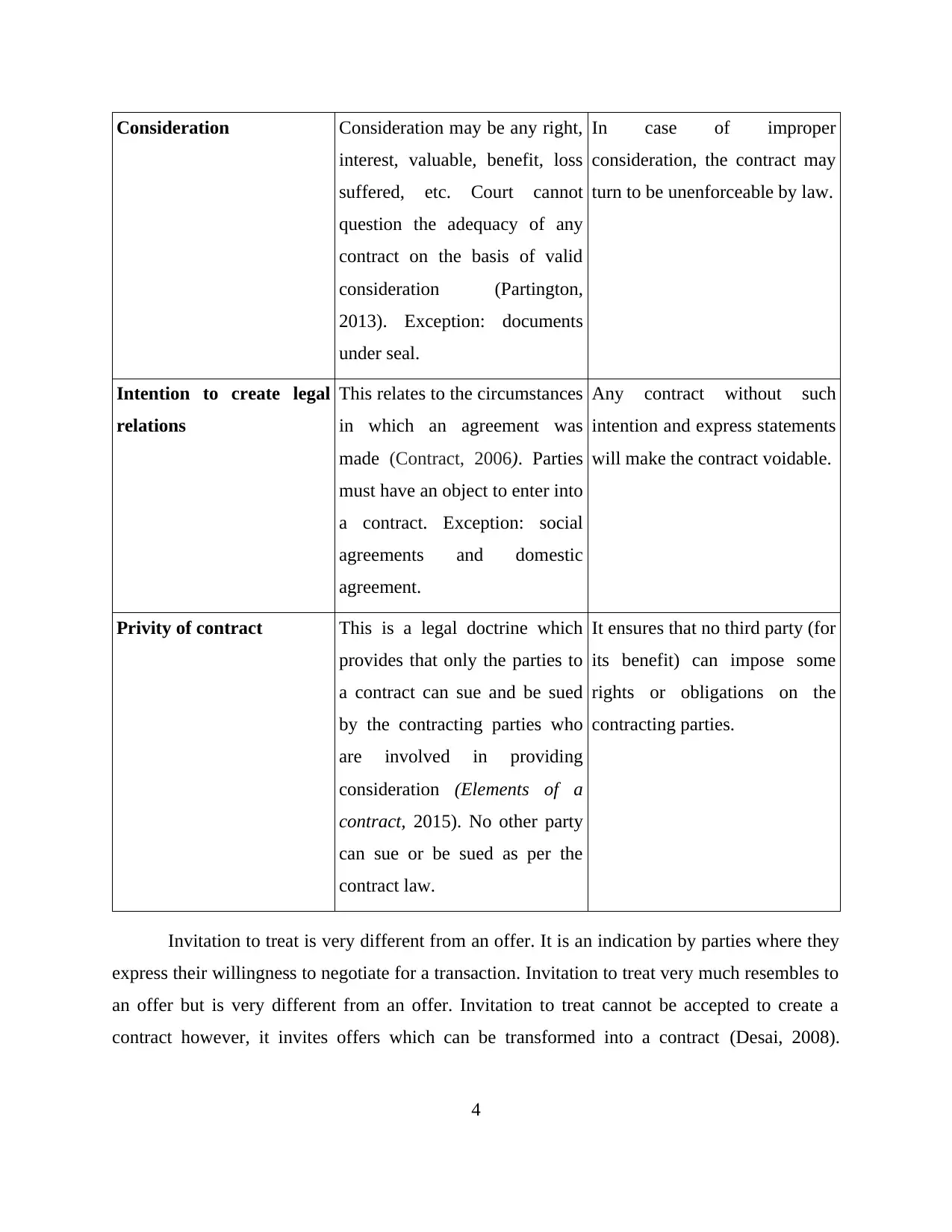
Consideration Consideration may be any right,
interest, valuable, benefit, loss
suffered, etc. Court cannot
question the adequacy of any
contract on the basis of valid
consideration (Partington,
2013). Exception: documents
under seal.
In case of improper
consideration, the contract may
turn to be unenforceable by law.
Intention to create legal
relations
This relates to the circumstances
in which an agreement was
made (Contract, 2006). Parties
must have an object to enter into
a contract. Exception: social
agreements and domestic
agreement.
Any contract without such
intention and express statements
will make the contract voidable.
Privity of contract This is a legal doctrine which
provides that only the parties to
a contract can sue and be sued
by the contracting parties who
are involved in providing
consideration (Elements of a
contract, 2015). No other party
can sue or be sued as per the
contract law.
It ensures that no third party (for
its benefit) can impose some
rights or obligations on the
contracting parties.
Invitation to treat is very different from an offer. It is an indication by parties where they
express their willingness to negotiate for a transaction. Invitation to treat very much resembles to
an offer but is very different from an offer. Invitation to treat cannot be accepted to create a
contract however, it invites offers which can be transformed into a contract (Desai, 2008).
4
interest, valuable, benefit, loss
suffered, etc. Court cannot
question the adequacy of any
contract on the basis of valid
consideration (Partington,
2013). Exception: documents
under seal.
In case of improper
consideration, the contract may
turn to be unenforceable by law.
Intention to create legal
relations
This relates to the circumstances
in which an agreement was
made (Contract, 2006). Parties
must have an object to enter into
a contract. Exception: social
agreements and domestic
agreement.
Any contract without such
intention and express statements
will make the contract voidable.
Privity of contract This is a legal doctrine which
provides that only the parties to
a contract can sue and be sued
by the contracting parties who
are involved in providing
consideration (Elements of a
contract, 2015). No other party
can sue or be sued as per the
contract law.
It ensures that no third party (for
its benefit) can impose some
rights or obligations on the
contracting parties.
Invitation to treat is very different from an offer. It is an indication by parties where they
express their willingness to negotiate for a transaction. Invitation to treat very much resembles to
an offer but is very different from an offer. Invitation to treat cannot be accepted to create a
contract however, it invites offers which can be transformed into a contract (Desai, 2008).
4
Secure Best Marks with AI Grader
Need help grading? Try our AI Grader for instant feedback on your assignments.
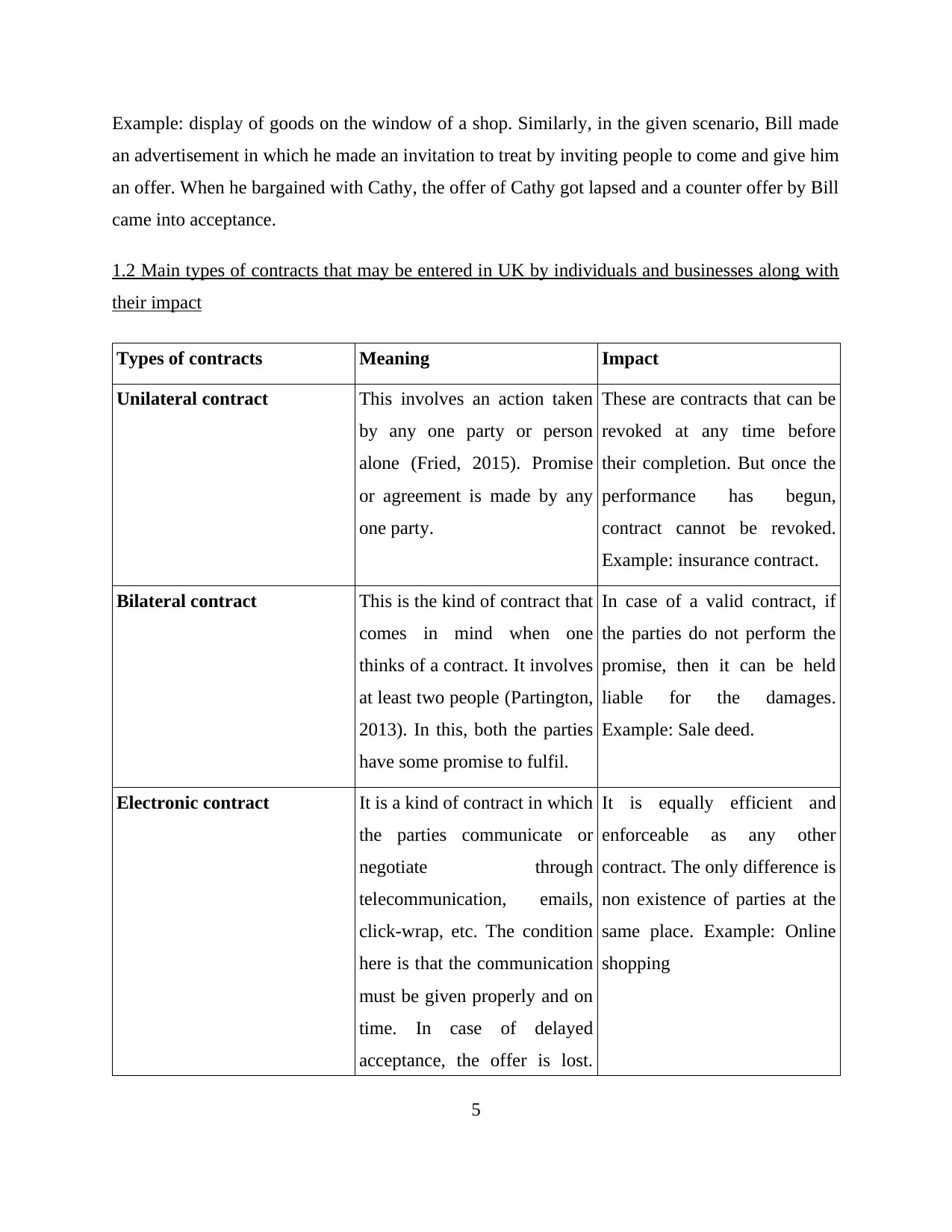
Example: display of goods on the window of a shop. Similarly, in the given scenario, Bill made
an advertisement in which he made an invitation to treat by inviting people to come and give him
an offer. When he bargained with Cathy, the offer of Cathy got lapsed and a counter offer by Bill
came into acceptance.
1.2 Main types of contracts that may be entered in UK by individuals and businesses along with
their impact
Types of contracts Meaning Impact
Unilateral contract This involves an action taken
by any one party or person
alone (Fried, 2015). Promise
or agreement is made by any
one party.
These are contracts that can be
revoked at any time before
their completion. But once the
performance has begun,
contract cannot be revoked.
Example: insurance contract.
Bilateral contract This is the kind of contract that
comes in mind when one
thinks of a contract. It involves
at least two people (Partington,
2013). In this, both the parties
have some promise to fulfil.
In case of a valid contract, if
the parties do not perform the
promise, then it can be held
liable for the damages.
Example: Sale deed.
Electronic contract It is a kind of contract in which
the parties communicate or
negotiate through
telecommunication, emails,
click-wrap, etc. The condition
here is that the communication
must be given properly and on
time. In case of delayed
acceptance, the offer is lost.
It is equally efficient and
enforceable as any other
contract. The only difference is
non existence of parties at the
same place. Example: Online
shopping
5
an advertisement in which he made an invitation to treat by inviting people to come and give him
an offer. When he bargained with Cathy, the offer of Cathy got lapsed and a counter offer by Bill
came into acceptance.
1.2 Main types of contracts that may be entered in UK by individuals and businesses along with
their impact
Types of contracts Meaning Impact
Unilateral contract This involves an action taken
by any one party or person
alone (Fried, 2015). Promise
or agreement is made by any
one party.
These are contracts that can be
revoked at any time before
their completion. But once the
performance has begun,
contract cannot be revoked.
Example: insurance contract.
Bilateral contract This is the kind of contract that
comes in mind when one
thinks of a contract. It involves
at least two people (Partington,
2013). In this, both the parties
have some promise to fulfil.
In case of a valid contract, if
the parties do not perform the
promise, then it can be held
liable for the damages.
Example: Sale deed.
Electronic contract It is a kind of contract in which
the parties communicate or
negotiate through
telecommunication, emails,
click-wrap, etc. The condition
here is that the communication
must be given properly and on
time. In case of delayed
acceptance, the offer is lost.
It is equally efficient and
enforceable as any other
contract. The only difference is
non existence of parties at the
same place. Example: Online
shopping
5
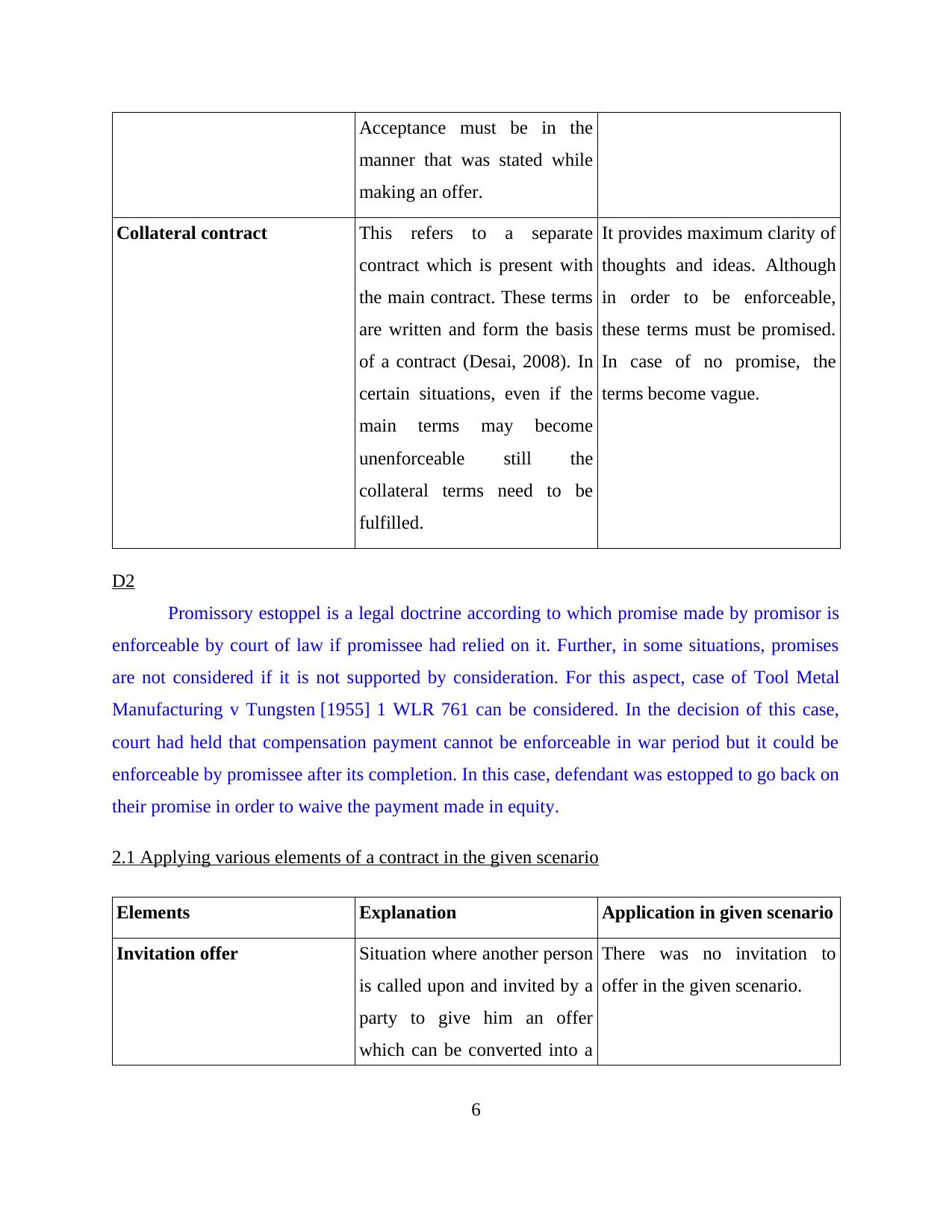
Acceptance must be in the
manner that was stated while
making an offer.
Collateral contract This refers to a separate
contract which is present with
the main contract. These terms
are written and form the basis
of a contract (Desai, 2008). In
certain situations, even if the
main terms may become
unenforceable still the
collateral terms need to be
fulfilled.
It provides maximum clarity of
thoughts and ideas. Although
in order to be enforceable,
these terms must be promised.
In case of no promise, the
terms become vague.
D2
Promissory estoppel is a legal doctrine according to which promise made by promisor is
enforceable by court of law if promissee had relied on it. Further, in some situations, promises
are not considered if it is not supported by consideration. For this aspect, case of Tool Metal
Manufacturing v Tungsten [1955] 1 WLR 761 can be considered. In the decision of this case,
court had held that compensation payment cannot be enforceable in war period but it could be
enforceable by promissee after its completion. In this case, defendant was estopped to go back on
their promise in order to waive the payment made in equity.
2.1 Applying various elements of a contract in the given scenario
Elements Explanation Application in given scenario
Invitation offer Situation where another person
is called upon and invited by a
party to give him an offer
which can be converted into a
There was no invitation to
offer in the given scenario.
6
manner that was stated while
making an offer.
Collateral contract This refers to a separate
contract which is present with
the main contract. These terms
are written and form the basis
of a contract (Desai, 2008). In
certain situations, even if the
main terms may become
unenforceable still the
collateral terms need to be
fulfilled.
It provides maximum clarity of
thoughts and ideas. Although
in order to be enforceable,
these terms must be promised.
In case of no promise, the
terms become vague.
D2
Promissory estoppel is a legal doctrine according to which promise made by promisor is
enforceable by court of law if promissee had relied on it. Further, in some situations, promises
are not considered if it is not supported by consideration. For this aspect, case of Tool Metal
Manufacturing v Tungsten [1955] 1 WLR 761 can be considered. In the decision of this case,
court had held that compensation payment cannot be enforceable in war period but it could be
enforceable by promissee after its completion. In this case, defendant was estopped to go back on
their promise in order to waive the payment made in equity.
2.1 Applying various elements of a contract in the given scenario
Elements Explanation Application in given scenario
Invitation offer Situation where another person
is called upon and invited by a
party to give him an offer
which can be converted into a
There was no invitation to
offer in the given scenario.
6
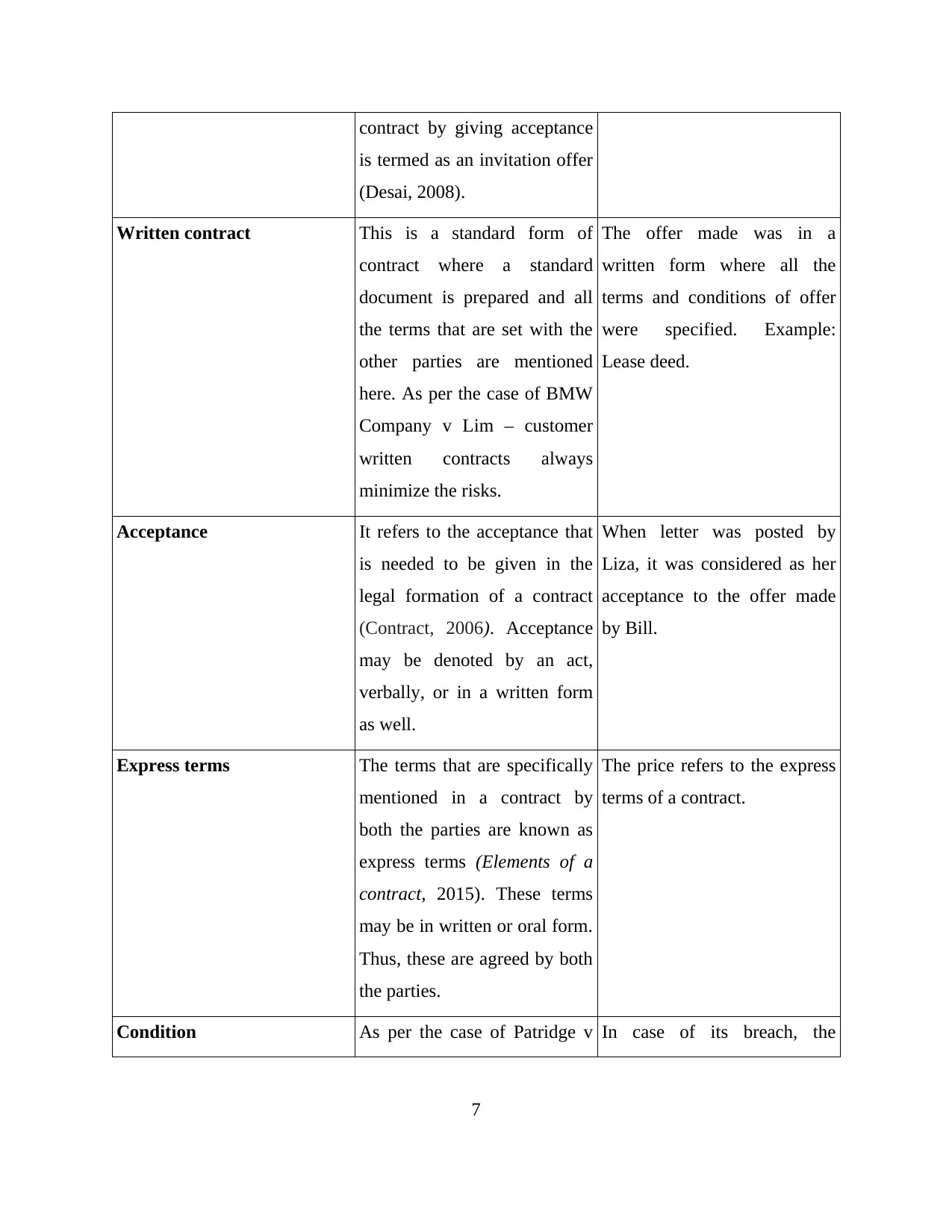
contract by giving acceptance
is termed as an invitation offer
(Desai, 2008).
Written contract This is a standard form of
contract where a standard
document is prepared and all
the terms that are set with the
other parties are mentioned
here. As per the case of BMW
Company v Lim – customer
written contracts always
minimize the risks.
The offer made was in a
written form where all the
terms and conditions of offer
were specified. Example:
Lease deed.
Acceptance It refers to the acceptance that
is needed to be given in the
legal formation of a contract
(Contract, 2006). Acceptance
may be denoted by an act,
verbally, or in a written form
as well.
When letter was posted by
Liza, it was considered as her
acceptance to the offer made
by Bill.
Express terms The terms that are specifically
mentioned in a contract by
both the parties are known as
express terms (Elements of a
contract, 2015). These terms
may be in written or oral form.
Thus, these are agreed by both
the parties.
The price refers to the express
terms of a contract.
Condition As per the case of Patridge v In case of its breach, the
7
is termed as an invitation offer
(Desai, 2008).
Written contract This is a standard form of
contract where a standard
document is prepared and all
the terms that are set with the
other parties are mentioned
here. As per the case of BMW
Company v Lim – customer
written contracts always
minimize the risks.
The offer made was in a
written form where all the
terms and conditions of offer
were specified. Example:
Lease deed.
Acceptance It refers to the acceptance that
is needed to be given in the
legal formation of a contract
(Contract, 2006). Acceptance
may be denoted by an act,
verbally, or in a written form
as well.
When letter was posted by
Liza, it was considered as her
acceptance to the offer made
by Bill.
Express terms The terms that are specifically
mentioned in a contract by
both the parties are known as
express terms (Elements of a
contract, 2015). These terms
may be in written or oral form.
Thus, these are agreed by both
the parties.
The price refers to the express
terms of a contract.
Condition As per the case of Patridge v In case of its breach, the
7
Paraphrase This Document
Need a fresh take? Get an instant paraphrase of this document with our AI Paraphraser
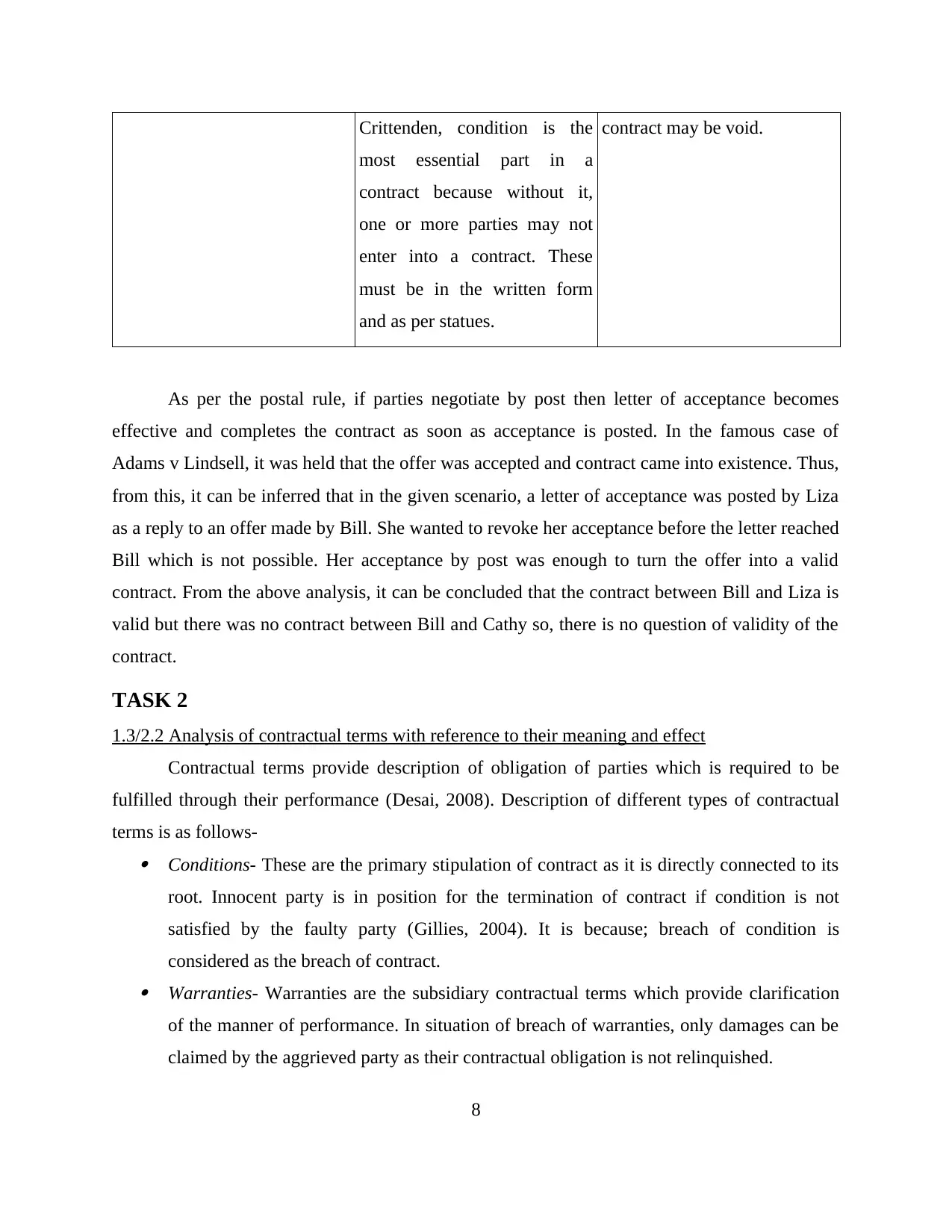
Crittenden, condition is the
most essential part in a
contract because without it,
one or more parties may not
enter into a contract. These
must be in the written form
and as per statues.
contract may be void.
As per the postal rule, if parties negotiate by post then letter of acceptance becomes
effective and completes the contract as soon as acceptance is posted. In the famous case of
Adams v Lindsell, it was held that the offer was accepted and contract came into existence. Thus,
from this, it can be inferred that in the given scenario, a letter of acceptance was posted by Liza
as a reply to an offer made by Bill. She wanted to revoke her acceptance before the letter reached
Bill which is not possible. Her acceptance by post was enough to turn the offer into a valid
contract. From the above analysis, it can be concluded that the contract between Bill and Liza is
valid but there was no contract between Bill and Cathy so, there is no question of validity of the
contract.
TASK 2
1.3/2.2 Analysis of contractual terms with reference to their meaning and effect
Contractual terms provide description of obligation of parties which is required to be
fulfilled through their performance (Desai, 2008). Description of different types of contractual
terms is as follows- Conditions- These are the primary stipulation of contract as it is directly connected to its
root. Innocent party is in position for the termination of contract if condition is not
satisfied by the faulty party (Gillies, 2004). It is because; breach of condition is
considered as the breach of contract. Warranties- Warranties are the subsidiary contractual terms which provide clarification
of the manner of performance. In situation of breach of warranties, only damages can be
claimed by the aggrieved party as their contractual obligation is not relinquished.
8
most essential part in a
contract because without it,
one or more parties may not
enter into a contract. These
must be in the written form
and as per statues.
contract may be void.
As per the postal rule, if parties negotiate by post then letter of acceptance becomes
effective and completes the contract as soon as acceptance is posted. In the famous case of
Adams v Lindsell, it was held that the offer was accepted and contract came into existence. Thus,
from this, it can be inferred that in the given scenario, a letter of acceptance was posted by Liza
as a reply to an offer made by Bill. She wanted to revoke her acceptance before the letter reached
Bill which is not possible. Her acceptance by post was enough to turn the offer into a valid
contract. From the above analysis, it can be concluded that the contract between Bill and Liza is
valid but there was no contract between Bill and Cathy so, there is no question of validity of the
contract.
TASK 2
1.3/2.2 Analysis of contractual terms with reference to their meaning and effect
Contractual terms provide description of obligation of parties which is required to be
fulfilled through their performance (Desai, 2008). Description of different types of contractual
terms is as follows- Conditions- These are the primary stipulation of contract as it is directly connected to its
root. Innocent party is in position for the termination of contract if condition is not
satisfied by the faulty party (Gillies, 2004). It is because; breach of condition is
considered as the breach of contract. Warranties- Warranties are the subsidiary contractual terms which provide clarification
of the manner of performance. In situation of breach of warranties, only damages can be
claimed by the aggrieved party as their contractual obligation is not relinquished.
8
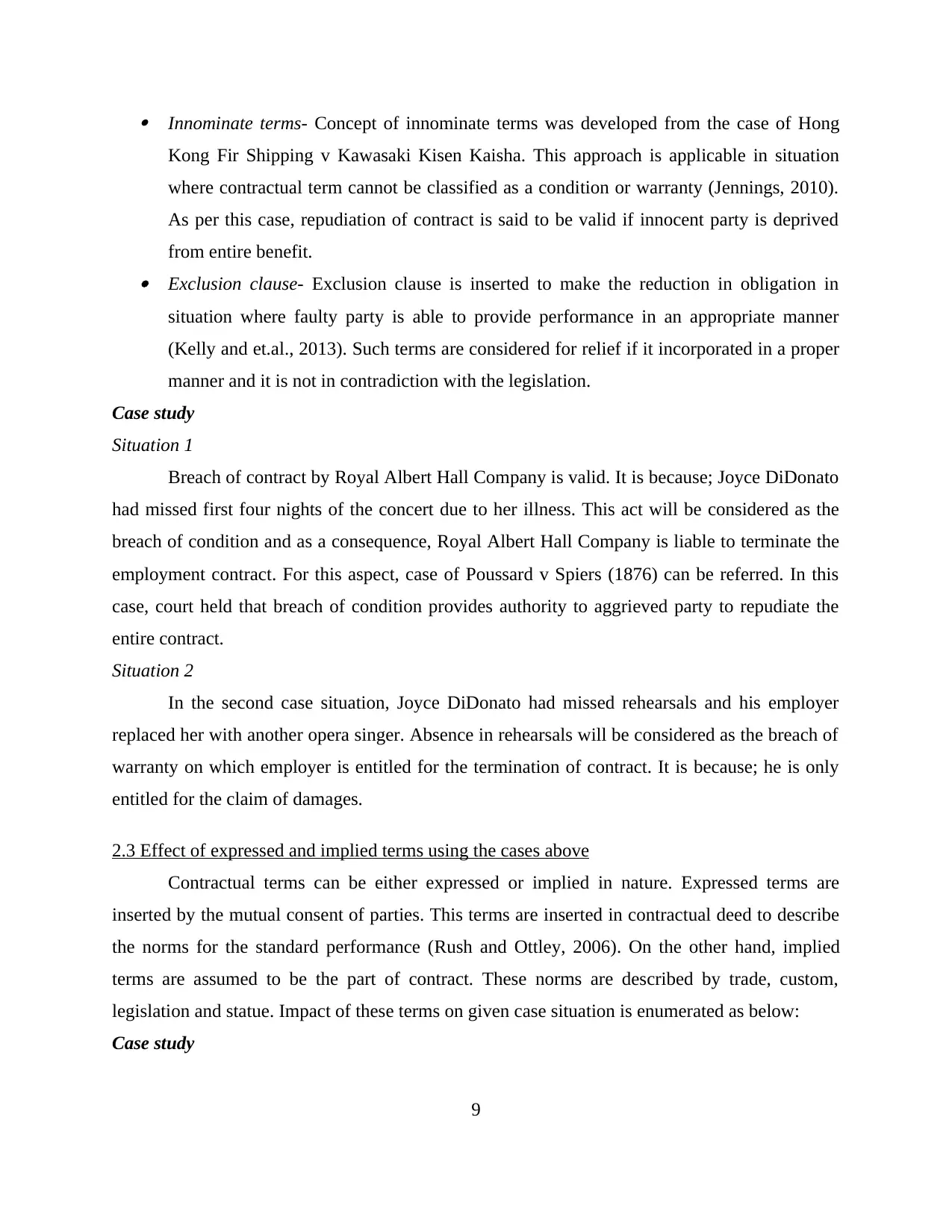
Innominate terms- Concept of innominate terms was developed from the case of Hong
Kong Fir Shipping v Kawasaki Kisen Kaisha. This approach is applicable in situation
where contractual term cannot be classified as a condition or warranty (Jennings, 2010).
As per this case, repudiation of contract is said to be valid if innocent party is deprived
from entire benefit. Exclusion clause- Exclusion clause is inserted to make the reduction in obligation in
situation where faulty party is able to provide performance in an appropriate manner
(Kelly and et.al., 2013). Such terms are considered for relief if it incorporated in a proper
manner and it is not in contradiction with the legislation.
Case study
Situation 1
Breach of contract by Royal Albert Hall Company is valid. It is because; Joyce DiDonato
had missed first four nights of the concert due to her illness. This act will be considered as the
breach of condition and as a consequence, Royal Albert Hall Company is liable to terminate the
employment contract. For this aspect, case of Poussard v Spiers (1876) can be referred. In this
case, court held that breach of condition provides authority to aggrieved party to repudiate the
entire contract.
Situation 2
In the second case situation, Joyce DiDonato had missed rehearsals and his employer
replaced her with another opera singer. Absence in rehearsals will be considered as the breach of
warranty on which employer is entitled for the termination of contract. It is because; he is only
entitled for the claim of damages.
2.3 Effect of expressed and implied terms using the cases above
Contractual terms can be either expressed or implied in nature. Expressed terms are
inserted by the mutual consent of parties. This terms are inserted in contractual deed to describe
the norms for the standard performance (Rush and Ottley, 2006). On the other hand, implied
terms are assumed to be the part of contract. These norms are described by trade, custom,
legislation and statue. Impact of these terms on given case situation is enumerated as below:
Case study
9
Kong Fir Shipping v Kawasaki Kisen Kaisha. This approach is applicable in situation
where contractual term cannot be classified as a condition or warranty (Jennings, 2010).
As per this case, repudiation of contract is said to be valid if innocent party is deprived
from entire benefit. Exclusion clause- Exclusion clause is inserted to make the reduction in obligation in
situation where faulty party is able to provide performance in an appropriate manner
(Kelly and et.al., 2013). Such terms are considered for relief if it incorporated in a proper
manner and it is not in contradiction with the legislation.
Case study
Situation 1
Breach of contract by Royal Albert Hall Company is valid. It is because; Joyce DiDonato
had missed first four nights of the concert due to her illness. This act will be considered as the
breach of condition and as a consequence, Royal Albert Hall Company is liable to terminate the
employment contract. For this aspect, case of Poussard v Spiers (1876) can be referred. In this
case, court held that breach of condition provides authority to aggrieved party to repudiate the
entire contract.
Situation 2
In the second case situation, Joyce DiDonato had missed rehearsals and his employer
replaced her with another opera singer. Absence in rehearsals will be considered as the breach of
warranty on which employer is entitled for the termination of contract. It is because; he is only
entitled for the claim of damages.
2.3 Effect of expressed and implied terms using the cases above
Contractual terms can be either expressed or implied in nature. Expressed terms are
inserted by the mutual consent of parties. This terms are inserted in contractual deed to describe
the norms for the standard performance (Rush and Ottley, 2006). On the other hand, implied
terms are assumed to be the part of contract. These norms are described by trade, custom,
legislation and statue. Impact of these terms on given case situation is enumerated as below:
Case study
9
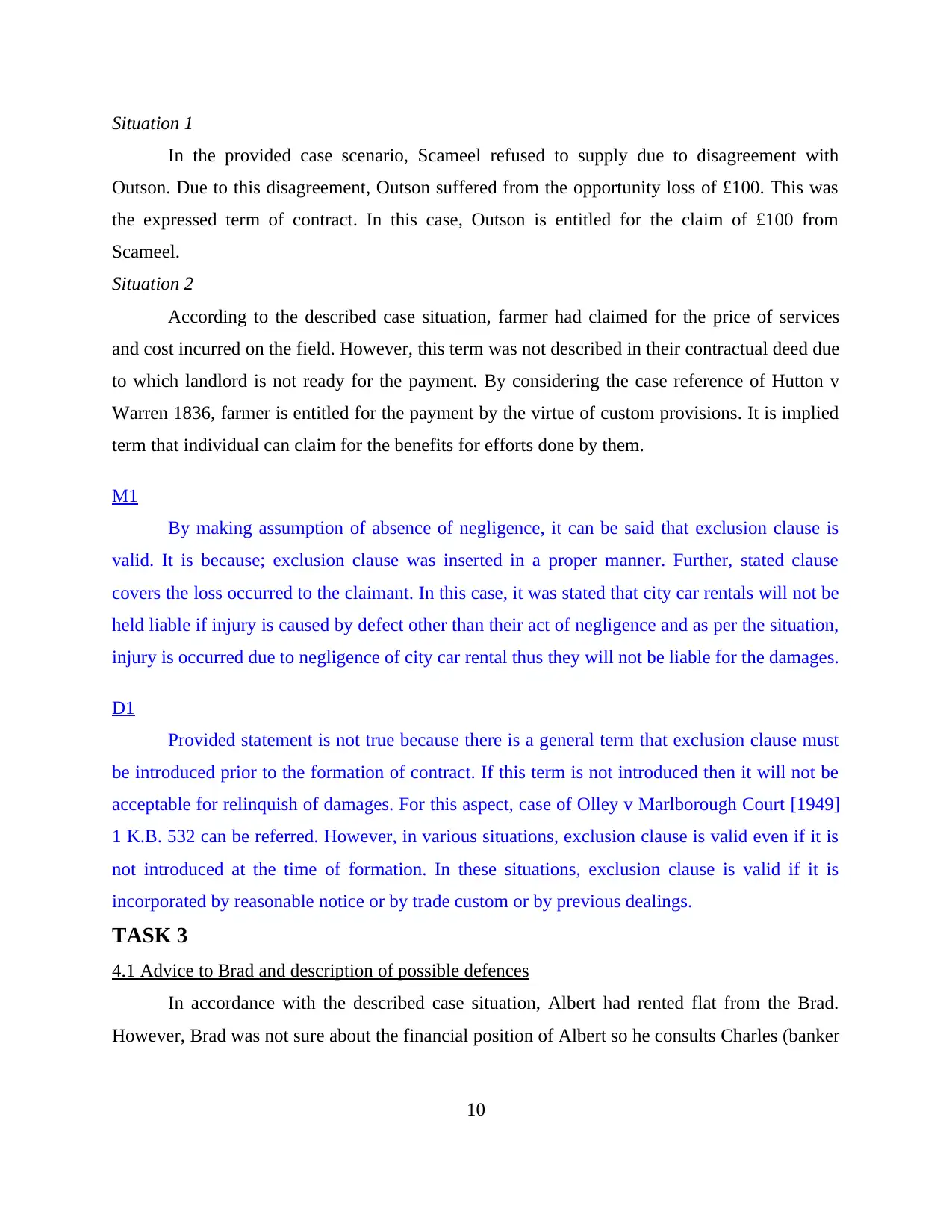
Situation 1
In the provided case scenario, Scameel refused to supply due to disagreement with
Outson. Due to this disagreement, Outson suffered from the opportunity loss of £100. This was
the expressed term of contract. In this case, Outson is entitled for the claim of £100 from
Scameel.
Situation 2
According to the described case situation, farmer had claimed for the price of services
and cost incurred on the field. However, this term was not described in their contractual deed due
to which landlord is not ready for the payment. By considering the case reference of Hutton v
Warren 1836, farmer is entitled for the payment by the virtue of custom provisions. It is implied
term that individual can claim for the benefits for efforts done by them.
M1
By making assumption of absence of negligence, it can be said that exclusion clause is
valid. It is because; exclusion clause was inserted in a proper manner. Further, stated clause
covers the loss occurred to the claimant. In this case, it was stated that city car rentals will not be
held liable if injury is caused by defect other than their act of negligence and as per the situation,
injury is occurred due to negligence of city car rental thus they will not be liable for the damages.
D1
Provided statement is not true because there is a general term that exclusion clause must
be introduced prior to the formation of contract. If this term is not introduced then it will not be
acceptable for relinquish of damages. For this aspect, case of Olley v Marlborough Court [1949]
1 K.B. 532 can be referred. However, in various situations, exclusion clause is valid even if it is
not introduced at the time of formation. In these situations, exclusion clause is valid if it is
incorporated by reasonable notice or by trade custom or by previous dealings.
TASK 3
4.1 Advice to Brad and description of possible defences
In accordance with the described case situation, Albert had rented flat from the Brad.
However, Brad was not sure about the financial position of Albert so he consults Charles (banker
10
In the provided case scenario, Scameel refused to supply due to disagreement with
Outson. Due to this disagreement, Outson suffered from the opportunity loss of £100. This was
the expressed term of contract. In this case, Outson is entitled for the claim of £100 from
Scameel.
Situation 2
According to the described case situation, farmer had claimed for the price of services
and cost incurred on the field. However, this term was not described in their contractual deed due
to which landlord is not ready for the payment. By considering the case reference of Hutton v
Warren 1836, farmer is entitled for the payment by the virtue of custom provisions. It is implied
term that individual can claim for the benefits for efforts done by them.
M1
By making assumption of absence of negligence, it can be said that exclusion clause is
valid. It is because; exclusion clause was inserted in a proper manner. Further, stated clause
covers the loss occurred to the claimant. In this case, it was stated that city car rentals will not be
held liable if injury is caused by defect other than their act of negligence and as per the situation,
injury is occurred due to negligence of city car rental thus they will not be liable for the damages.
D1
Provided statement is not true because there is a general term that exclusion clause must
be introduced prior to the formation of contract. If this term is not introduced then it will not be
acceptable for relinquish of damages. For this aspect, case of Olley v Marlborough Court [1949]
1 K.B. 532 can be referred. However, in various situations, exclusion clause is valid even if it is
not introduced at the time of formation. In these situations, exclusion clause is valid if it is
incorporated by reasonable notice or by trade custom or by previous dealings.
TASK 3
4.1 Advice to Brad and description of possible defences
In accordance with the described case situation, Albert had rented flat from the Brad.
However, Brad was not sure about the financial position of Albert so he consults Charles (banker
10
Secure Best Marks with AI Grader
Need help grading? Try our AI Grader for instant feedback on your assignments.
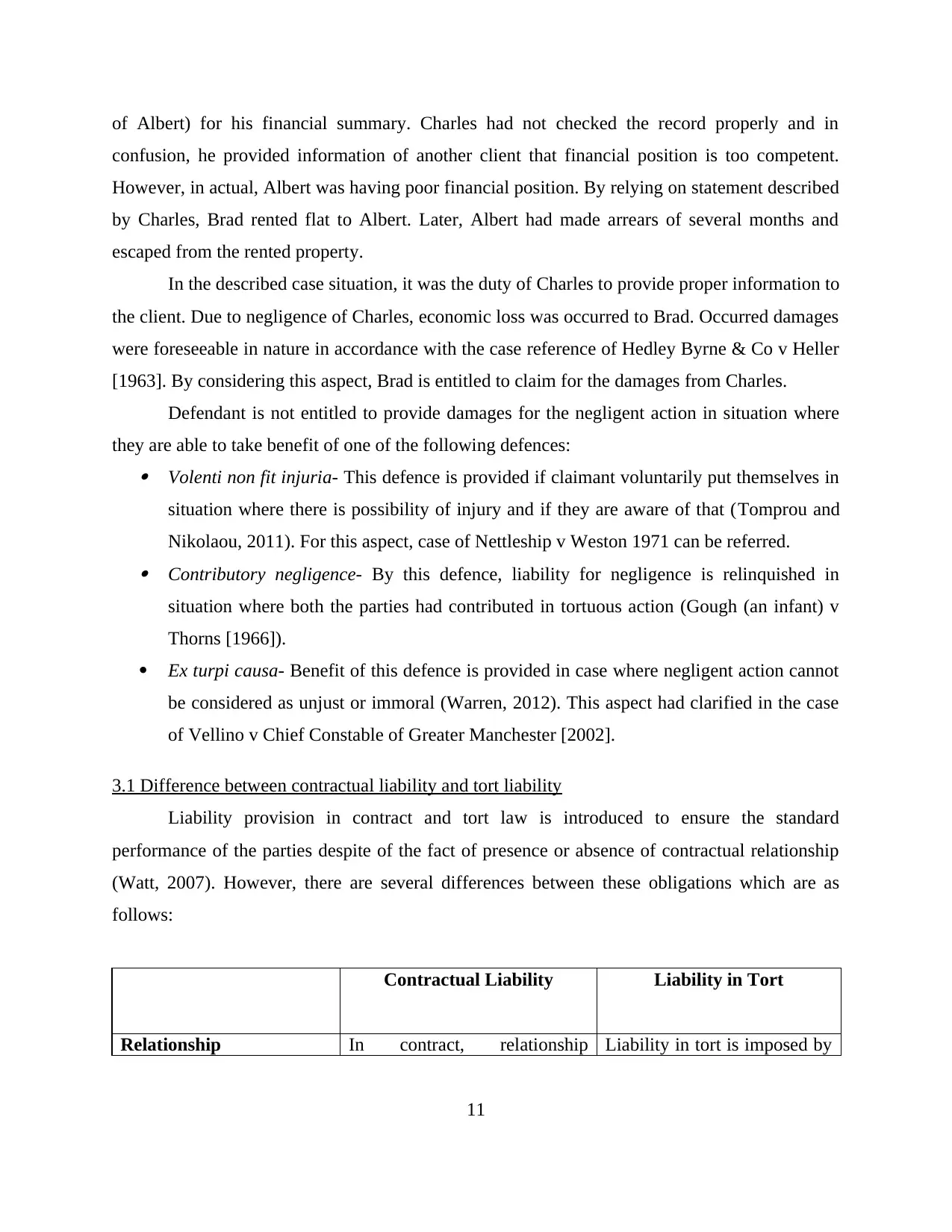
of Albert) for his financial summary. Charles had not checked the record properly and in
confusion, he provided information of another client that financial position is too competent.
However, in actual, Albert was having poor financial position. By relying on statement described
by Charles, Brad rented flat to Albert. Later, Albert had made arrears of several months and
escaped from the rented property.
In the described case situation, it was the duty of Charles to provide proper information to
the client. Due to negligence of Charles, economic loss was occurred to Brad. Occurred damages
were foreseeable in nature in accordance with the case reference of Hedley Byrne & Co v Heller
[1963]. By considering this aspect, Brad is entitled to claim for the damages from Charles.
Defendant is not entitled to provide damages for the negligent action in situation where
they are able to take benefit of one of the following defences: Volenti non fit injuria- This defence is provided if claimant voluntarily put themselves in
situation where there is possibility of injury and if they are aware of that (Tomprou and
Nikolaou, 2011). For this aspect, case of Nettleship v Weston 1971 can be referred. Contributory negligence- By this defence, liability for negligence is relinquished in
situation where both the parties had contributed in tortuous action (Gough (an infant) v
Thorns [1966]).
Ex turpi causa- Benefit of this defence is provided in case where negligent action cannot
be considered as unjust or immoral (Warren, 2012). This aspect had clarified in the case
of Vellino v Chief Constable of Greater Manchester [2002].
3.1 Difference between contractual liability and tort liability
Liability provision in contract and tort law is introduced to ensure the standard
performance of the parties despite of the fact of presence or absence of contractual relationship
(Watt, 2007). However, there are several differences between these obligations which are as
follows:
Contractual Liability Liability in Tort
Relationship In contract, relationship Liability in tort is imposed by
11
confusion, he provided information of another client that financial position is too competent.
However, in actual, Albert was having poor financial position. By relying on statement described
by Charles, Brad rented flat to Albert. Later, Albert had made arrears of several months and
escaped from the rented property.
In the described case situation, it was the duty of Charles to provide proper information to
the client. Due to negligence of Charles, economic loss was occurred to Brad. Occurred damages
were foreseeable in nature in accordance with the case reference of Hedley Byrne & Co v Heller
[1963]. By considering this aspect, Brad is entitled to claim for the damages from Charles.
Defendant is not entitled to provide damages for the negligent action in situation where
they are able to take benefit of one of the following defences: Volenti non fit injuria- This defence is provided if claimant voluntarily put themselves in
situation where there is possibility of injury and if they are aware of that (Tomprou and
Nikolaou, 2011). For this aspect, case of Nettleship v Weston 1971 can be referred. Contributory negligence- By this defence, liability for negligence is relinquished in
situation where both the parties had contributed in tortuous action (Gough (an infant) v
Thorns [1966]).
Ex turpi causa- Benefit of this defence is provided in case where negligent action cannot
be considered as unjust or immoral (Warren, 2012). This aspect had clarified in the case
of Vellino v Chief Constable of Greater Manchester [2002].
3.1 Difference between contractual liability and tort liability
Liability provision in contract and tort law is introduced to ensure the standard
performance of the parties despite of the fact of presence or absence of contractual relationship
(Watt, 2007). However, there are several differences between these obligations which are as
follows:
Contractual Liability Liability in Tort
Relationship In contract, relationship Liability in tort is imposed by
11
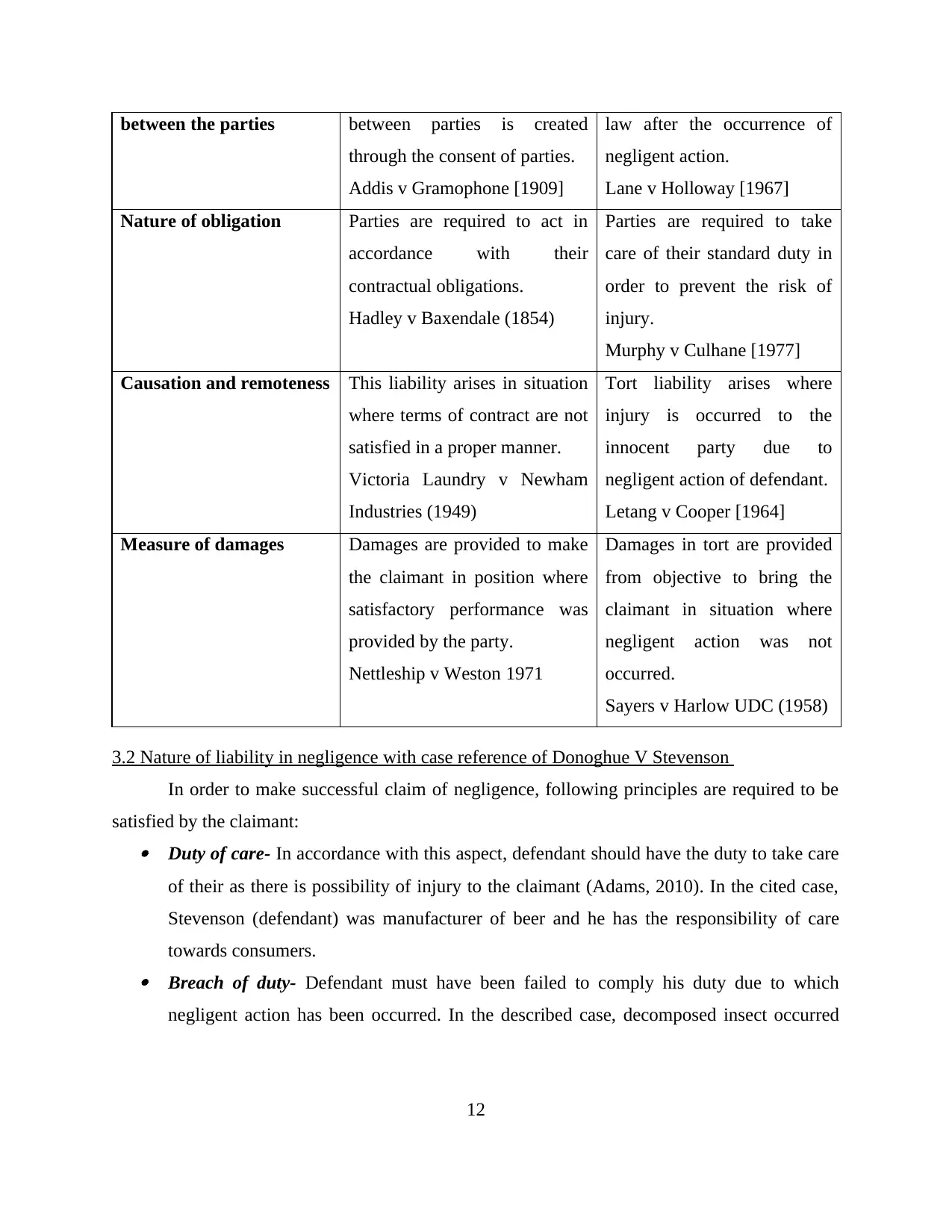
between the parties between parties is created
through the consent of parties.
Addis v Gramophone [1909]
law after the occurrence of
negligent action.
Lane v Holloway [1967]
Nature of obligation Parties are required to act in
accordance with their
contractual obligations.
Hadley v Baxendale (1854)
Parties are required to take
care of their standard duty in
order to prevent the risk of
injury.
Murphy v Culhane [1977]
Causation and remoteness This liability arises in situation
where terms of contract are not
satisfied in a proper manner.
Victoria Laundry v Newham
Industries (1949)
Tort liability arises where
injury is occurred to the
innocent party due to
negligent action of defendant.
Letang v Cooper [1964]
Measure of damages Damages are provided to make
the claimant in position where
satisfactory performance was
provided by the party.
Nettleship v Weston 1971
Damages in tort are provided
from objective to bring the
claimant in situation where
negligent action was not
occurred.
Sayers v Harlow UDC (1958)
3.2 Nature of liability in negligence with case reference of Donoghue V Stevenson
In order to make successful claim of negligence, following principles are required to be
satisfied by the claimant: Duty of care- In accordance with this aspect, defendant should have the duty to take care
of their as there is possibility of injury to the claimant (Adams, 2010). In the cited case,
Stevenson (defendant) was manufacturer of beer and he has the responsibility of care
towards consumers. Breach of duty- Defendant must have been failed to comply his duty due to which
negligent action has been occurred. In the described case, decomposed insect occurred
12
through the consent of parties.
Addis v Gramophone [1909]
law after the occurrence of
negligent action.
Lane v Holloway [1967]
Nature of obligation Parties are required to act in
accordance with their
contractual obligations.
Hadley v Baxendale (1854)
Parties are required to take
care of their standard duty in
order to prevent the risk of
injury.
Murphy v Culhane [1977]
Causation and remoteness This liability arises in situation
where terms of contract are not
satisfied in a proper manner.
Victoria Laundry v Newham
Industries (1949)
Tort liability arises where
injury is occurred to the
innocent party due to
negligent action of defendant.
Letang v Cooper [1964]
Measure of damages Damages are provided to make
the claimant in position where
satisfactory performance was
provided by the party.
Nettleship v Weston 1971
Damages in tort are provided
from objective to bring the
claimant in situation where
negligent action was not
occurred.
Sayers v Harlow UDC (1958)
3.2 Nature of liability in negligence with case reference of Donoghue V Stevenson
In order to make successful claim of negligence, following principles are required to be
satisfied by the claimant: Duty of care- In accordance with this aspect, defendant should have the duty to take care
of their as there is possibility of injury to the claimant (Adams, 2010). In the cited case,
Stevenson (defendant) was manufacturer of beer and he has the responsibility of care
towards consumers. Breach of duty- Defendant must have been failed to comply his duty due to which
negligent action has been occurred. In the described case, decomposed insect occurred
12
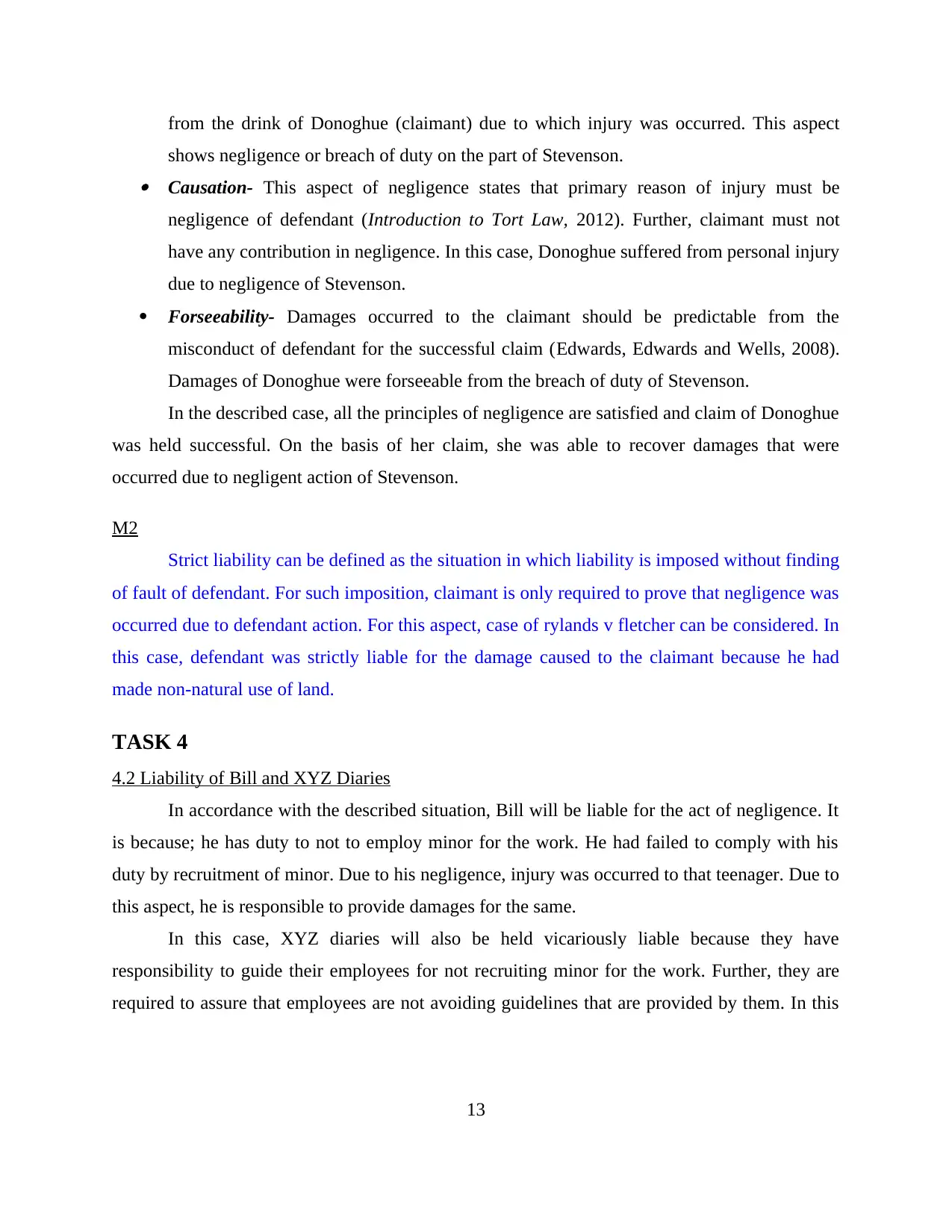
from the drink of Donoghue (claimant) due to which injury was occurred. This aspect
shows negligence or breach of duty on the part of Stevenson. Causation- This aspect of negligence states that primary reason of injury must be
negligence of defendant (Introduction to Tort Law, 2012). Further, claimant must not
have any contribution in negligence. In this case, Donoghue suffered from personal injury
due to negligence of Stevenson.
Forseeability- Damages occurred to the claimant should be predictable from the
misconduct of defendant for the successful claim (Edwards, Edwards and Wells, 2008).
Damages of Donoghue were forseeable from the breach of duty of Stevenson.
In the described case, all the principles of negligence are satisfied and claim of Donoghue
was held successful. On the basis of her claim, she was able to recover damages that were
occurred due to negligent action of Stevenson.
M2
Strict liability can be defined as the situation in which liability is imposed without finding
of fault of defendant. For such imposition, claimant is only required to prove that negligence was
occurred due to defendant action. For this aspect, case of rylands v fletcher can be considered. In
this case, defendant was strictly liable for the damage caused to the claimant because he had
made non-natural use of land.
TASK 4
4.2 Liability of Bill and XYZ Diaries
In accordance with the described situation, Bill will be liable for the act of negligence. It
is because; he has duty to not to employ minor for the work. He had failed to comply with his
duty by recruitment of minor. Due to his negligence, injury was occurred to that teenager. Due to
this aspect, he is responsible to provide damages for the same.
In this case, XYZ diaries will also be held vicariously liable because they have
responsibility to guide their employees for not recruiting minor for the work. Further, they are
required to assure that employees are not avoiding guidelines that are provided by them. In this
13
shows negligence or breach of duty on the part of Stevenson. Causation- This aspect of negligence states that primary reason of injury must be
negligence of defendant (Introduction to Tort Law, 2012). Further, claimant must not
have any contribution in negligence. In this case, Donoghue suffered from personal injury
due to negligence of Stevenson.
Forseeability- Damages occurred to the claimant should be predictable from the
misconduct of defendant for the successful claim (Edwards, Edwards and Wells, 2008).
Damages of Donoghue were forseeable from the breach of duty of Stevenson.
In the described case, all the principles of negligence are satisfied and claim of Donoghue
was held successful. On the basis of her claim, she was able to recover damages that were
occurred due to negligent action of Stevenson.
M2
Strict liability can be defined as the situation in which liability is imposed without finding
of fault of defendant. For such imposition, claimant is only required to prove that negligence was
occurred due to defendant action. For this aspect, case of rylands v fletcher can be considered. In
this case, defendant was strictly liable for the damage caused to the claimant because he had
made non-natural use of land.
TASK 4
4.2 Liability of Bill and XYZ Diaries
In accordance with the described situation, Bill will be liable for the act of negligence. It
is because; he has duty to not to employ minor for the work. He had failed to comply with his
duty by recruitment of minor. Due to his negligence, injury was occurred to that teenager. Due to
this aspect, he is responsible to provide damages for the same.
In this case, XYZ diaries will also be held vicariously liable because they have
responsibility to guide their employees for not recruiting minor for the work. Further, they are
required to assure that employees are not avoiding guidelines that are provided by them. In this
13
Paraphrase This Document
Need a fresh take? Get an instant paraphrase of this document with our AI Paraphraser
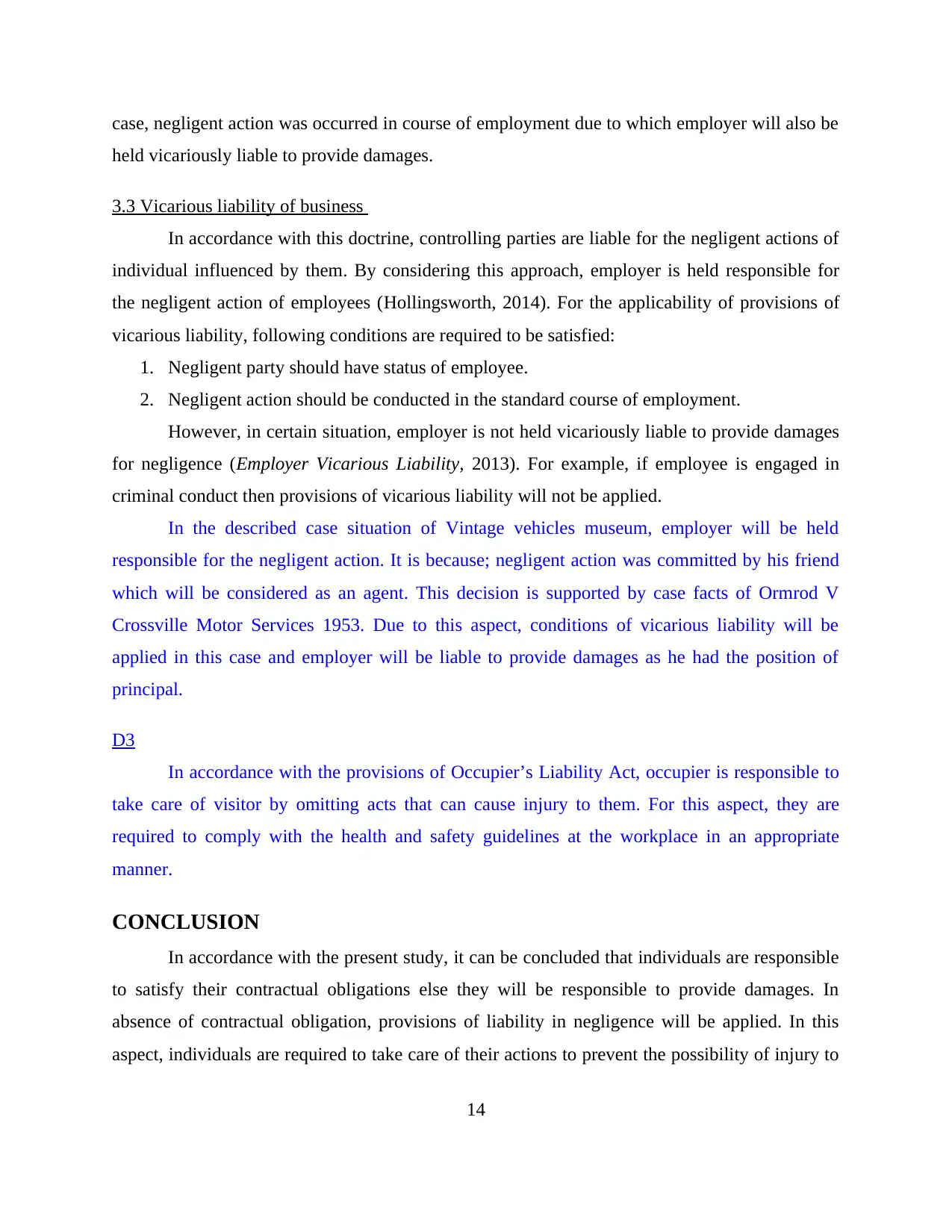
case, negligent action was occurred in course of employment due to which employer will also be
held vicariously liable to provide damages.
3.3 Vicarious liability of business
In accordance with this doctrine, controlling parties are liable for the negligent actions of
individual influenced by them. By considering this approach, employer is held responsible for
the negligent action of employees (Hollingsworth, 2014). For the applicability of provisions of
vicarious liability, following conditions are required to be satisfied:
1. Negligent party should have status of employee.
2. Negligent action should be conducted in the standard course of employment.
However, in certain situation, employer is not held vicariously liable to provide damages
for negligence (Employer Vicarious Liability, 2013). For example, if employee is engaged in
criminal conduct then provisions of vicarious liability will not be applied.
In the described case situation of Vintage vehicles museum, employer will be held
responsible for the negligent action. It is because; negligent action was committed by his friend
which will be considered as an agent. This decision is supported by case facts of Ormrod V
Crossville Motor Services 1953. Due to this aspect, conditions of vicarious liability will be
applied in this case and employer will be liable to provide damages as he had the position of
principal.
D3
In accordance with the provisions of Occupier’s Liability Act, occupier is responsible to
take care of visitor by omitting acts that can cause injury to them. For this aspect, they are
required to comply with the health and safety guidelines at the workplace in an appropriate
manner.
CONCLUSION
In accordance with the present study, it can be concluded that individuals are responsible
to satisfy their contractual obligations else they will be responsible to provide damages. In
absence of contractual obligation, provisions of liability in negligence will be applied. In this
aspect, individuals are required to take care of their actions to prevent the possibility of injury to
14
held vicariously liable to provide damages.
3.3 Vicarious liability of business
In accordance with this doctrine, controlling parties are liable for the negligent actions of
individual influenced by them. By considering this approach, employer is held responsible for
the negligent action of employees (Hollingsworth, 2014). For the applicability of provisions of
vicarious liability, following conditions are required to be satisfied:
1. Negligent party should have status of employee.
2. Negligent action should be conducted in the standard course of employment.
However, in certain situation, employer is not held vicariously liable to provide damages
for negligence (Employer Vicarious Liability, 2013). For example, if employee is engaged in
criminal conduct then provisions of vicarious liability will not be applied.
In the described case situation of Vintage vehicles museum, employer will be held
responsible for the negligent action. It is because; negligent action was committed by his friend
which will be considered as an agent. This decision is supported by case facts of Ormrod V
Crossville Motor Services 1953. Due to this aspect, conditions of vicarious liability will be
applied in this case and employer will be liable to provide damages as he had the position of
principal.
D3
In accordance with the provisions of Occupier’s Liability Act, occupier is responsible to
take care of visitor by omitting acts that can cause injury to them. For this aspect, they are
required to comply with the health and safety guidelines at the workplace in an appropriate
manner.
CONCLUSION
In accordance with the present study, it can be concluded that individuals are responsible
to satisfy their contractual obligations else they will be responsible to provide damages. In
absence of contractual obligation, provisions of liability in negligence will be applied. In this
aspect, individuals are required to take care of their actions to prevent the possibility of injury to
14
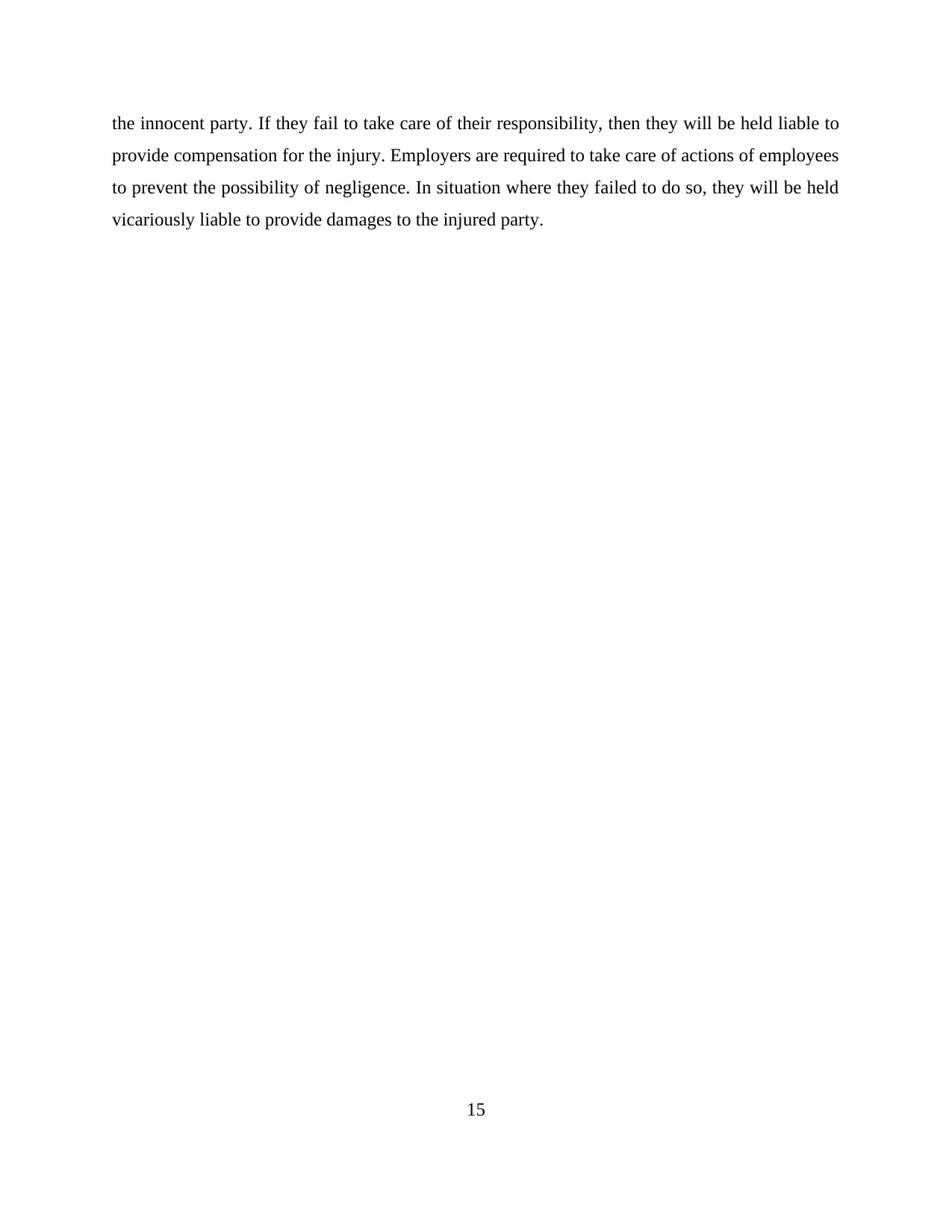
the innocent party. If they fail to take care of their responsibility, then they will be held liable to
provide compensation for the injury. Employers are required to take care of actions of employees
to prevent the possibility of negligence. In situation where they failed to do so, they will be held
vicariously liable to provide damages to the injured party.
15
provide compensation for the injury. Employers are required to take care of actions of employees
to prevent the possibility of negligence. In situation where they failed to do so, they will be held
vicariously liable to provide damages to the injured party.
15
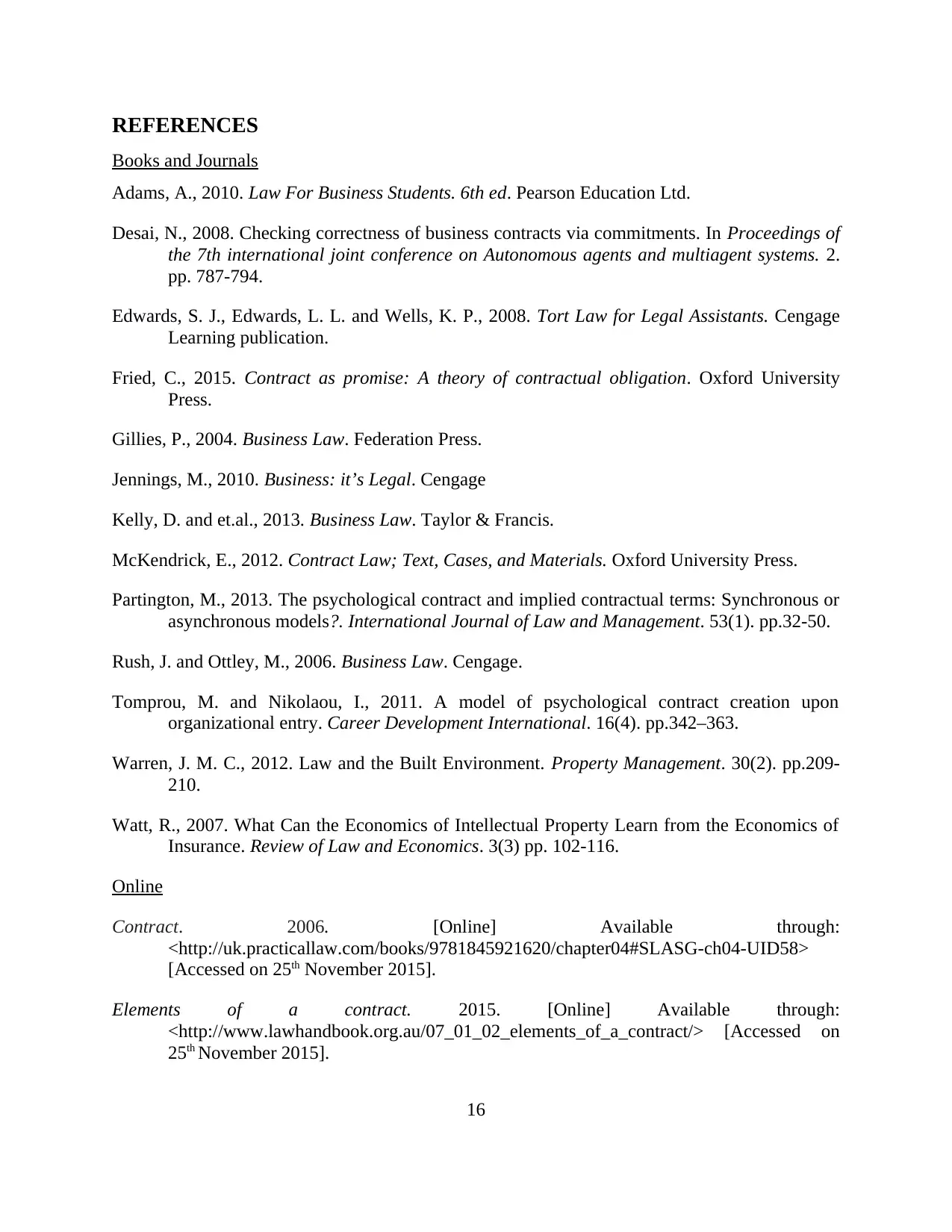
REFERENCES
Books and Journals
Adams, A., 2010. Law For Business Students. 6th ed. Pearson Education Ltd.
Desai, N., 2008. Checking correctness of business contracts via commitments. In Proceedings of
the 7th international joint conference on Autonomous agents and multiagent systems. 2.
pp. 787-794.
Edwards, S. J., Edwards, L. L. and Wells, K. P., 2008. Tort Law for Legal Assistants. Cengage
Learning publication.
Fried, C., 2015. Contract as promise: A theory of contractual obligation. Oxford University
Press.
Gillies, P., 2004. Business Law. Federation Press.
Jennings, M., 2010. Business: it’s Legal. Cengage
Kelly, D. and et.al., 2013. Business Law. Taylor & Francis.
McKendrick, E., 2012. Contract Law; Text, Cases, and Materials. Oxford University Press.
Partington, M., 2013. The psychological contract and implied contractual terms: Synchronous or
asynchronous models?. International Journal of Law and Management. 53(1). pp.32-50.
Rush, J. and Ottley, M., 2006. Business Law. Cengage.
Tomprou, M. and Nikolaou, I., 2011. A model of psychological contract creation upon
organizational entry. Career Development International. 16(4). pp.342–363.
Warren, J. M. C., 2012. Law and the Built Environment. Property Management. 30(2). pp.209-
210.
Watt, R., 2007. What Can the Economics of Intellectual Property Learn from the Economics of
Insurance. Review of Law and Economics. 3(3) pp. 102-116.
Online
Contract. 2006. [Online] Available through:
<http://uk.practicallaw.com/books/9781845921620/chapter04#SLASG-ch04-UID58>
[Accessed on 25th November 2015].
Elements of a contract. 2015. [Online] Available through:
<http://www.lawhandbook.org.au/07_01_02_elements_of_a_contract/> [Accessed on
25th November 2015].
16
Books and Journals
Adams, A., 2010. Law For Business Students. 6th ed. Pearson Education Ltd.
Desai, N., 2008. Checking correctness of business contracts via commitments. In Proceedings of
the 7th international joint conference on Autonomous agents and multiagent systems. 2.
pp. 787-794.
Edwards, S. J., Edwards, L. L. and Wells, K. P., 2008. Tort Law for Legal Assistants. Cengage
Learning publication.
Fried, C., 2015. Contract as promise: A theory of contractual obligation. Oxford University
Press.
Gillies, P., 2004. Business Law. Federation Press.
Jennings, M., 2010. Business: it’s Legal. Cengage
Kelly, D. and et.al., 2013. Business Law. Taylor & Francis.
McKendrick, E., 2012. Contract Law; Text, Cases, and Materials. Oxford University Press.
Partington, M., 2013. The psychological contract and implied contractual terms: Synchronous or
asynchronous models?. International Journal of Law and Management. 53(1). pp.32-50.
Rush, J. and Ottley, M., 2006. Business Law. Cengage.
Tomprou, M. and Nikolaou, I., 2011. A model of psychological contract creation upon
organizational entry. Career Development International. 16(4). pp.342–363.
Warren, J. M. C., 2012. Law and the Built Environment. Property Management. 30(2). pp.209-
210.
Watt, R., 2007. What Can the Economics of Intellectual Property Learn from the Economics of
Insurance. Review of Law and Economics. 3(3) pp. 102-116.
Online
Contract. 2006. [Online] Available through:
<http://uk.practicallaw.com/books/9781845921620/chapter04#SLASG-ch04-UID58>
[Accessed on 25th November 2015].
Elements of a contract. 2015. [Online] Available through:
<http://www.lawhandbook.org.au/07_01_02_elements_of_a_contract/> [Accessed on
25th November 2015].
16
1 out of 16
Related Documents
Your All-in-One AI-Powered Toolkit for Academic Success.
+13062052269
info@desklib.com
Available 24*7 on WhatsApp / Email
![[object Object]](/_next/static/media/star-bottom.7253800d.svg)
Unlock your academic potential
© 2024 | Zucol Services PVT LTD | All rights reserved.





